 Ethiopia is considered a developing country due to several key factors related to its economic, social, and infrastructure development. While the country has made significant progress, it still faces numerous challenges typical of developing nations. Here are the main reasons:
Ethiopia is considered a developing country due to several key factors related to its economic, social, and infrastructure development. While the country has made significant progress, it still faces numerous challenges typical of developing nations. Here are the main reasons:
1. Low Income Levels
- Low GDP per Capita: Ethiopia’s gross domestic product (GDP) per capita is relatively low compared to developed countries. This means that the average income of its citizens is below the global average, indicating widespread poverty and low living standards.
- High Poverty Rates: A significant portion of Ethiopia’s population lives in poverty. Despite economic growth, large groups, particularly in rural areas, lack access to basic services like healthcare, education, and clean water.
2. Dependence on Agriculture
- Agricultural Economy: A large proportion of Ethiopia’s population depends on agriculture for their livelihoods. However, the sector is highly vulnerable to climate fluctuations, including droughts and floods. This makes the economy unstable and limits growth, as agriculture accounts for a substantial share of the country’s GDP.
- Low Productivity in Agriculture: Productivity in agriculture is still relatively low due to limited access to modern farming technologies, inefficient farming practices, and inadequate infrastructure.
3. Limited Industrialization and Infrastructure
- Underdeveloped Industry: Ethiopia’s industrial sector is still in the early stages of development. The country is working on building industrial parks and attracting foreign investment, but its industrial output remains low compared to developed nations.
- Infrastructure Challenges: Ethiopia faces infrastructure deficits, particularly in rural areas. Roads, electricity, and access to clean water are limited in many regions, which hinders economic growth and quality of life.
4. Political Instability and Conflict
- Ethnic Tensions and Civil Conflict: Ethiopia has experienced political instability and ethnic tensions that have led to conflict, displacement, and disruption of economic activities. These factors have slowed down the country’s development.
- Governance and Corruption: Despite reforms, Ethiopia faces challenges related to governance, such as corruption, inefficiency, and political struggles that can hinder the delivery of essential services and long-term development.
5. Social Issues
- Health and Education: Although there have been improvements in both sectors, healthcare and education in Ethiopia still face challenges. Access to quality healthcare is limited, leading to high rates of preventable diseases and low life expectancy. Education systems also face overcrowded classrooms, a shortage of trained teachers, and limited resources.
- Gender Inequality: Women in Ethiopia often face significant barriers to education, employment, and healthcare, which limits their economic contributions and perpetuates poverty.
6. Vulnerability to Climate Change
- Environmental Challenges: Ethiopia is highly susceptible to the effects of climate change, including droughts, irregular rainfall, and desertification. These factors negatively impact agriculture, which is the backbone of the economy, and lead to food insecurity, displacement, and environmental degradation.
7. Limited Access to Technology and Innovation
- Technological Development: Ethiopia has limited access to advanced technology and lacks significant investment in innovation and research and development. The country is working on improving its technological capacity, but it still lags behind many other nations in terms of digital infrastructure, innovation, and industry 4.0 technologies.
8. External Debt and Aid Dependence
- Debt Burden: Ethiopia has faced challenges related to external debt, which hampers economic growth and development. High debt levels can limit the government’s ability to invest in long-term projects that would drive development.
- Reliance on Foreign Aid: While the country is making strides in becoming more self-sufficient, Ethiopia has historically relied on foreign aid for its development needs. This dependence on aid can sometimes limit the country’s ability to chart its own development path and be self-reliant.
9. Geographical Challenges
- Landlocked Status: Being landlocked, Ethiopia faces higher transportation costs for imports and exports, which can hinder trade and economic growth. It has to rely on neighboring countries for access to ports, which increases its trade costs.
Positive Aspects of Ethiopia’s Development:
Despite these challenges, Ethiopia has shown progress in several areas:
- Economic Growth: Ethiopia has been one of the fastest-growing economies in Africa in recent years, with a focus on infrastructure projects such as roads, railways, and energy generation.
- Renewable Energy: The country has vast renewable energy resources, particularly in hydroelectric power, and has been making investments to develop this sector.
- Improving Education and Health: There have been significant improvements in literacy rates, school enrollment, and access to basic healthcare in some regions.
In summary, Ethiopia is considered a developing country due to its low income levels, reliance on agriculture, infrastructure deficits, political instability, and vulnerability to external and internal challenges. However, its recent economic growth and efforts to improve infrastructure and human development hold promise for future progress.
4o mini

















